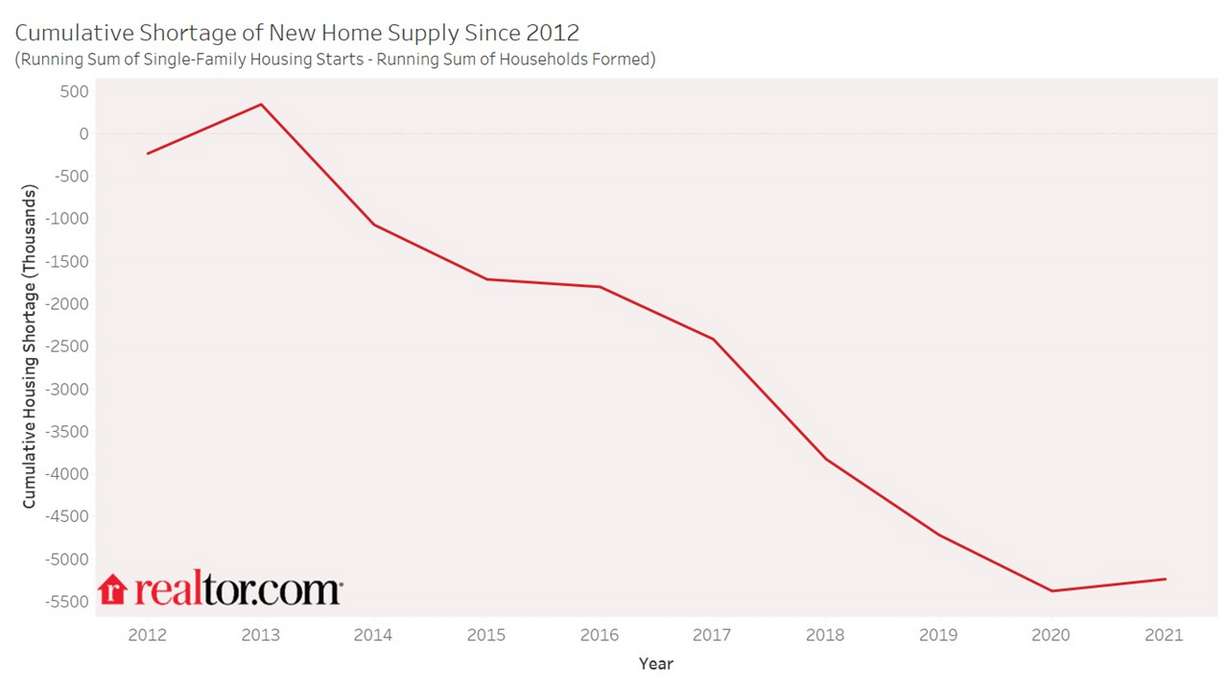Estimated read time: 4-5 minutes
This archived news story is available only for your personal, non-commercial use. Information in the story may be outdated or superseded by additional information. Reading or replaying the story in its archived form does not constitute a republication of the story.
LAS VEGAS — As Western states, including Utah, Idaho, Arizona and Nevada, cap off two years of record-breaking home sales and price increases, it's important to note the West's housing crunch began long before the COVID-19 pandemic threw the national housing market into upheaval.
That's because the entire U.S. — and especially burgeoning Western states — has been facing a housing shortage for over a decade now after homebuilding contracted in 2009 amid the Great Recession.
"The housing market has been struggling to keep up with demand since the 2010s, when the number of new homes built was slashed in half compared with the previous decade," Forbes wrote. "As the demand for residential real estate has increased, the scarcity of homes for sale has created a logjam on the supply side."
- The U.S. is now short 5.24 million homes, according to recent research by Realtor.com. That gap between single-family home constructions and household formations is up from a shortage of 3.84 million homes at the beginning of 2019.
- Homebuilding hasn't kept pace with population growth. In 2020 and the first half of 2021, the U.S. saw 2.1 million household formations, resulting in a total of 12.3 million household formations between 2012 and June 2021, according to Realtor.com. In that time period, only 7 million single-family homes were built and completed.

Single-family homebuilding has suffered a severe labor shortage that began well before the pandemic, but it was certainly exacerbated by labor and supply chain issues amid COVID-19.
- The coronavirus pandemic changed daily life worldwide. Being stuck at home led to a re-examination of home life, resulting in increased housing demand across the country," Realtor.com wrote. "However, as housing demand ramped up, the construction industry ran into issues with material and labor scarcity, driving the cost of both inputs up and widening the already large gap between home construction and household formations. Housing demand was strong enough that these hang-ups did not stifle home sales growth, but these trends exacerbated the preexisting shortage, making the problem worse."
Now zoom in to rapidly growing Western states like Utah, Idaho, Nevada and Idaho — states that also saw some of the top year-over-year increases in home sales in 2021, according to a home price index CoreLogic published earlier this month.
- The states with the highest increases year over year were Arizona (28.8%), Idaho (28.7%), and Utah (24.5%). Nevada came in close behind Florida with a 24.2% year-over-year increase.
- The site Realtor.com ranked Salt Lake City as the No. 1 housing market positioned for growth in 2022, forecasting the metro to see a 15.2% year-over-year sales growth and an 8.5% year-over-year increase in prices. Its closest competitor, Boise, ranked close behind as the No. 2 housing market in the nation forecasted for 2022.
The faster the population growth, the more homebuilders have struggled to keep up with demand.
- In Utah — which has been the fastest-growing state in the nation over the past 10 years — growth in households outpaced growth in housing units.
- Utah's cumulative housing shortage from 2010 to 2020 totals 44,500 units, according to a report published in October titled "The State of the State's Housing Market," by the University of Utah's Kem C. Gardner Policy Institute.
- That same report found Utah's housing market is facing a "severe imbalance" that's creating record price increases for homeowners and renters. For instance, more than half of Utah's households are now unable to afford the state's median priced home, which for single-family homes was $460,000 in 2021.

States that were especially hard-hit by the Great Recession are still grappling with its impact in the form of a housing shortage.
- Nevada, especially, saw home prices plummet during the Great Recession — a staggering 60% drop, according to a 2018 report titled "Evaluating the Housing Market Since the Great Recession," by the financial services company CoreLogic.
Today's affordable housing shortage in southern Nevada's Las Vegas Valley is a result of homebuilding contraction amid the Great Recession.
- Prior to the 2008 crash, "we were building up to 38,000" homes a year, Aldo Martinez, 2021 president of Las Vegas Realtors, recently told FOX5 Vegas. After the recession, Las Vegas started building only 5,000 to 10,000 homes a year — not enough to keep pace with southern Nevada's population growth, Martinez said, resulting in a 117,000 home shortage over 12 years.









